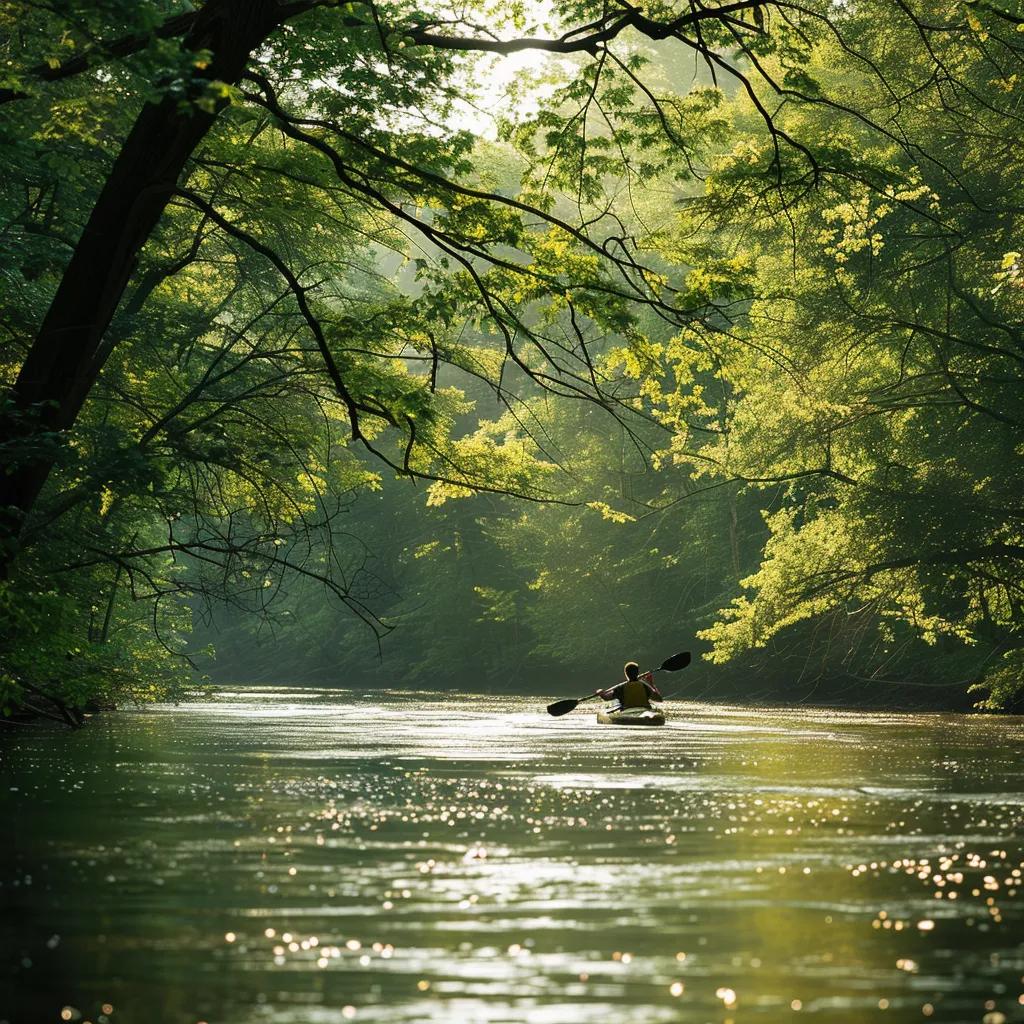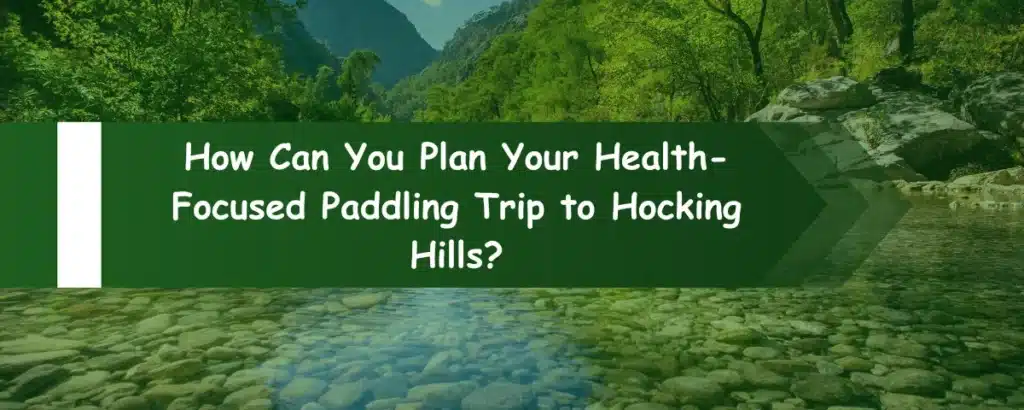
Paddle into Fitness: Canoeing and Kayaking in Hocking Hills
Imagine gliding along the Hocking River’s crystalline waters as your heart rate climbs, muscles engage, and worries drift away. Canoeing and kayaking in Hocking Hills combine dynamic paddling with immersive nature therapy to deliver a full-body workout, mental refreshment, and a sense of adventure. In this guide, you’ll discover:
- The key physical benefits, from cardiovascular gains to muscle strengthening, calorie burn, and joint-friendly low-impact fitness.
- The mental and emotional rewards of blue-health immersion, stress reduction, mood enhancement, and confidence building.
- Why Hocking Hills and the Hocking River’s scenic routes and rich biodiversity amplify these health advantages.
- A comparative analysis of canoeing vs. kayaking for different fitness goals.
- The essential gear to maximize safety, comfort, and performance.
- Clarifications on common questions about paddling’s health impact.
- A step-by-step plan to prepare and schedule your next health-focused paddling trip.
By integrating canoeing and kayaking on the Hocking River into your routine, you’ll develop endurance, strength, mindfulness, and resilience. Next, we examine the core physical benefits that make paddling an exceptional low-impact exercise.
What Are the Physical Health Benefits of Canoeing and Kayaking?

Canoeing and kayaking deliver a multifaceted workout by combining sustained aerobic effort with targeted muscle engagement. These paddle sports enhance cardiovascular capacity, build muscular strength, support weight management, and protect joints through low-impact movement. Exploring how each benefit unfolds will show why paddling is an ideal exercise for all ages and fitness levels.
How Does Paddling Improve Cardiovascular Health and Endurance?
Paddling elevates heart rate to 60–75% of maximum, stimulating cardiac output and improving circulation. By engaging in continuous strokes, your body increases oxygen uptake (VO₂) and strengthens heart muscle fibers. For example, a 30-minute kayak session can raise stroke volume and lower resting heart rate over weeks of practice. These changes foster greater endurance, enabling you to paddle longer distances on the Hocking River’s tranquil flows and hidden rapids.
Cardiovascular Benefits of Paddling
Paddling elevates heart rate and improves circulation, increasing oxygen uptake and strengthening heart muscle fibers. Regular paddling sessions can lead to greater endurance and a lower resting heart rate.
This research supports the article’s claims about the cardiovascular benefits of canoeing and kayaking.
Which Muscle Groups Does Canoeing and Kayaking Strengthen?
Paddling activates multiple muscle groups in a coordinated sequence:
- Core muscles (abdominals and obliques) stabilize the torso with each stroke.
- Upper-body muscles (latissimus dorsi, deltoids, biceps, and forearms) generate paddle power.
- Back muscles (trapezius, rhomboids) support posture and stroke recovery.
- Leg muscles (quadriceps and calves) brace against foot braces or hull edges for balance.
These combined efforts enhance overall strength and improve posture, laying the foundation for efficient paddling mechanics and injury prevention.
How Many Calories Can You Burn While Paddling?
Below is an EAV-style overview of calorie expenditure during typical paddling activities:
| Activity | Calorie Burn (per hour) | Intensity Level |
|---|---|---|
| Canoeing | 300–500 calories | Moderate |
| Kayaking | 400–600 calories | Moderate to Vigorous |
Burning 400 calories in an hour of kayaking contributes significantly toward the CDC’s weekly recommendation of 150 minutes of moderate-intensity activity. Consistent paddling sessions support weight management and metabolic health.
Calorie Expenditure During Paddling
Kayaking can burn a significant number of calories per hour, contributing to the recommended weekly moderate-intensity activity guidelines. Consistent paddling supports weight management and metabolic health.
This citation provides evidence for the calorie-burning potential of kayaking, as mentioned in the article.
Why Is Canoeing and Kayaking Considered Low-Impact Exercise?
Paddling glides your body over water with minimal joint compression, making it gentle on knees, hips, and ankles. Unlike running or high-impact sports, the smooth stroke cycle absorbs shock and distributes forces evenly across core and upper-body muscles. This joint-friendly profile is ideal for older adults, individuals recovering from injury, or anyone seeking to protect their skeletal system while gaining cardiovascular and muscular benefits. As you master paddling technique, you’ll enjoy sustained fitness gains without the wear and tear of land-based workouts.
How Does Paddling Enhance Mental and Emotional Well-Being?

Beyond physical gains, time spent paddling on the Hocking River taps into the science of “blue health,” where water environments foster stress reduction, improved mood, and a boost in self-esteem. The combination of rhythmic movement, fresh air, and scenic vistas cultivates mindfulness and resilience.
Blue Health and Mental Well-being
Spending time in water environments can reduce stress and improve mood. The combination of rhythmic movement, fresh air, and scenic vistas cultivates mindfulness and resilience.
This research supports the article’s claims about the mental and emotional benefits of paddling.
How Does Nature Immersion on the Hocking River Reduce Stress and Anxiety?
Spending as little as 15 minutes on the riverbank can lower cortisol levels by 16%. As you navigate through forested riverbanks, sunlight dapples the water and wildlife sightings engage your senses. These natural stimuli promote parasympathetic activation, slowing heart rate and easing muscle tension. The gentle lapping of water and birdsong reinforce meditative focus, helping to dissolve anxiety and mental fatigue.
Can Canoeing and Kayaking Improve Mood and Cognitive Function?
Yes, paddling enhances neurotransmitter balance by increasing serotonin and dopamine release. The coordinated bilateral strokes stimulate neural pathways associated with focus and clarity, while the demanding coordination engages both hemispheres of the brain. Regular outings on Hocking River routes have been linked to improved executive function, sharper attention spans, and elevated mood states, supporting depression management and cognitive resilience.
How Does Paddling Build Confidence and Self-Esteem?
Mastering paddling skills, from navigating gentle currents to executing controlled turns, cultivates a sense of accomplishment. Each mile you traverse develops problem-solving and decision-making under variable conditions, reinforcing self-efficacy. Overcoming initial challenges on water transitions into greater confidence in daily life, illustrating how outdoor adventure fosters personal growth and emotional strength.
Why Is Hocking Hills the Ideal Destination for Health-Boosting Paddling?

Hocking Hills State Park provides an unparalleled natural classroom for paddling enthusiasts. Its geological formations, diverse wildlife, and accessible riverbanks create an environment that magnifies both physical exertion and emotional restoration.
What Scenic Routes and Natural Features Make Hocking River Perfect for Paddling?
The Hocking River winds through sandstone gorges, hemlock-shaded coves, and panoramic overlooks. Key routes include:
- Rockbridge Rapids: gentle class I–II riffles that build skill.
- Lake Logan Loop: a calm backwater circuit ideal for nature watching.
- Cedar Falls Corridor: scenery featuring cascading rock formations.
How Do Hocking Hills’ Natural Surroundings Enhance the Health Benefits of Paddling?
The park’s old-growth forests filter noise pollution, while native flora emit phytoncides, organic compounds shown to boost immunity. Wildlife encounters and seasonal wildflower displays engage multiple sensory pathways, deepening mindfulness and promoting mental restoration. Paddling amid this biodiversity intensifies the stress-relief and mood-enhancement effects of blue health experiences.
Where Can You Rent Canoes and Kayaks in Hocking Hills?
Local outfitters along Logan’s riverfront offer a range of rentals:
- Hocking Hills Canoe Livery: guided trips and overnight tours.
- AdventurePro Outdoors: family-friendly rentals with safety gear.
- Logan Paddle Shop: lightweight kayaks geared toward fitness paddlers.
What Safety Tips Should You Know Before Paddling in Hocking Hills?
Prioritize safety by:
- Wearing a properly fitted, Coast Guard–approved PFD at all times.
- Checking weather forecasts, avoid paddling during high winds or storms.
- Staying hydrated and packing energy-dense snacks for multi-hour outings.
- Informing someone onshore of your route and expected return time.
Adhering to these precautions ensures a secure and enjoyable paddling experience amid Hocking Hills’ stunning backdrop.
How Does Canoeing and Kayaking Differ in Health Benefits and Experience?

While both paddle sports share core health advantages, their distinct vessel designs and stroke techniques create unique physical and skill-based profiles.
What Are the Key Differences Between Canoeing and Kayaking?
Below is a comparative EAV table outlining vessel and benefit distinctions:
| Paddle Sport | Vessel Type | Primary Benefits |
|---|---|---|
| Canoeing | Open hull, single-blade | Emphasizes core stabilization and upper-body power |
| Kayaking | Enclosed cockpit, double-blade | Promotes balanced muscle engagement and endurance |
Canoeing encourages dynamic torso rotation, while kayaking’s dual-blade motion delivers a smoother stroke cycle and faster pace.
Which Paddle Sport Is Best for Your Fitness Level and Health Goals?
Beginners and those seeking stability often start with canoeing to focus on foundational strokes and balance. Fitness enthusiasts aiming for a higher calorie burn and cardiovascular challenge may prefer kayaking’s continuous bilateral paddling. Tailor your choice to accommodate personal goals, whether that’s endurance training, muscular conditioning, or mindful nature immersion.
How Can Proper Paddling Techniques Maximize Health Benefits?
Efficient paddling technique involves:
- Core engagement: brace your abs and obliques before each stroke.
- Full-body coordination: initiate the stroke with torso rotation rather than arm pulling.
- Posture alignment: sit upright, shoulders relaxed, and hips squared.
- Rhythmic breathing: inhale as the paddle enters the water, exhale during recovery.
These mechanics optimize power output, reduce fatigue, and amplify cardiovascular and muscle-building effects on each outing.
What Essential Gear Do You Need for a Healthy Paddling Experience?

Selecting the right equipment boosts performance, comfort, and safety—key factors in sustaining regular paddling for long-term health benefits.
What Are the Must-Have Canoeing and Kayaking Gear Items?
Before you launch, equip yourself with the following essentials:
| Equipment | Attribute | Benefit |
|---|---|---|
| Paddle | Lightweight aluminum or carbon | Efficient strokes with reduced fatigue |
| Personal Flotation Device | Coast Guard–approved, adjustable | Buoyancy support and increased safety |
| Helmet | Impact-resistant shell | Head protection in rapids or rocky areas |
| Waterproof Clothing | Quick-dry, UV-protective fabric | Comfort and skin protection in variable weather |
How Does Choosing the Right Gear Support Safety and Comfort?
Properly fitting equipment prevents strain and injury: a correctly sized PFD maintains buoyancy without chafing, and a paddle matched to your torso height preserves shoulder health. UV-protective apparel guards against sunburn during extended trips, and waterproof layers keep you warm in cooler temperatures. By optimizing gear, you can focus on paddling technique and fully reap the physical and mental rewards of the experience.
What Are Common Questions About the Health Benefits of Paddling?

Many aspiring paddlers wonder about age suitability, joint impact, muscle engagement, and mental health outcomes. Clarifying these points deepens understanding of paddling’s holistic advantages.
Is Kayaking a Good Workout for All Ages?
Yes. Kayaking’s adjustable intensity and low-impact nature make it suitable for children through seniors. Upright seating with PFD support reduces fall risk, while stroke cadence can be tailored to individual fitness levels, ensuring a safe yet challenging workout at any age.
How Does Canoeing Help With Joint Health and Low-Impact Fitness?
Canoeing’s smooth glide eliminates harsh impact on ankles, knees, and hips by distributing force across core and upper-body muscles. This fluid motion supports joint mobility, improves synovial fluid circulation, and reduces stiffness, making it an ideal exercise for those with arthritis or joint sensitivities.
What Muscles Does Kayaking Work Most Effectively?
Kayaking provides balanced engagement of:
- Latissimus dorsi and biceps during the power phase.
- Triceps and deltoids during recovery strokes.
- Abdominals and obliques for core stability.
This synergy builds upper-body strength while conditioning the torso and lower back.
How Does Spending Time on Water Improve Mental Health?
Water environments trigger a calming response in the autonomic nervous system, lowering cortisol and releasing endorphins. The combination of gentle motion, natural scenery, and focused breathing promotes mindfulness, relieves anxiety, and supports sustained emotional resilience.
How Can You Plan Your Health-Focused Paddling Trip to Hocking Hills?

Effective trip planning maximizes both safety and the health benefits of your paddling experience. Consider timing, physical preparation, and local expertise to ensure a seamless outing.
When Is the Best Time to Paddle in Hocking Hills for Health Benefits?
Spring (April–June) and fall (September–October) offer mild temperatures (60–75°F), low insect activity, and vibrant foliage. Early morning sessions provide calm water and fewer crowds, enhancing mindfulness and cardiovascular efficiency.
How to Prepare Physically and Mentally for Your Canoeing or Kayaking Adventure?
Begin with dynamic stretches targeting shoulders, core, and hips. Incorporate aerobic exercises, such as brisk walking or cycling, for two weeks prior to your trip to boost endurance. Practice mindfulness meditation or deep-breathing techniques to build focus and reduce pre-trip anxiety. This combined preparation ensures you maximize both physical performance and mental clarity on the water.
What Local Resources and Guides Can Enhance Your Paddling Experience?
Partner with certified guides from AdventurePro Outdoors or Hocking Hills Canoe Livery for personalized instruction, insider route recommendations, and safety briefings. Local paddling clubs and online forums also offer peer support, group excursions, and gear-sharing programs, enriching your journey and fostering community connections.
Smooth transitions from physical gains to mental wellness, location highlights to gear essentials, and planning strategies to practical resources ensure you’re fully equipped to turn Hocking Hills paddling into a sustainable health practice. Embrace the water, harness its healing power, and redefine your fitness journey one paddle stroke at a time.
Frequently Asked Questions

What is the best age to start canoeing or kayaking?
Canoeing and kayaking are suitable for all ages, from children to seniors. The adjustable intensity of these activities allows individuals to tailor their experience based on their fitness level and physical capabilities. Children can enjoy paddling with adult supervision, while seniors can benefit from the low-impact nature of these sports, making them ideal for maintaining fitness without excessive strain on the joints.
How can I ensure my safety while paddling in Hocking Hills?
To ensure safety while paddling, always wear a properly fitted, Coast Guard-approved personal flotation device (PFD). Check weather conditions before heading out, avoid paddling during storms, and stay hydrated. Inform someone onshore about your route and expected return time. Additionally, consider paddling with a partner or group for added safety and support during your adventure.
What should I wear for a comfortable paddling experience?
For a comfortable paddling experience, wear quick-drying, moisture-wicking clothing that provides UV protection. Layering is advisable to adapt to changing weather conditions. A hat and sunglasses can shield you from the sun, while waterproof clothing can keep you dry in case of splashes. Proper footwear, such as water shoes or sandals, can also enhance comfort and safety while navigating rocky areas.
How can I improve my paddling technique?
Improving your paddling technique involves focusing on core engagement, full-body coordination, and proper posture. Practice initiating strokes with your torso rather than just your arms, and maintain an upright position with relaxed shoulders. Regularly practicing rhythmic breathing can also enhance your endurance and efficiency. Consider taking lessons from experienced instructors to refine your skills and maximize the health benefits of paddling.
What are the environmental benefits of paddling in Hocking Hills?
Paddling in Hocking Hills promotes environmental awareness and appreciation for natural ecosystems. By engaging with the local flora and fauna, paddlers can develop a deeper understanding of the importance of conservation. Additionally, non-motorized paddling activities help reduce noise and air pollution, allowing for a more serene experience while minimizing the ecological footprint on the waterways and surrounding habitats.
Can paddling help with weight management?
Yes, paddling can significantly aid in weight management. Both canoeing and kayaking provide a robust cardiovascular workout, burning calories effectively. For instance, kayaking can burn between 400 to 600 calories per hour, depending on intensity. Regular paddling sessions, combined with a balanced diet, can help maintain a healthy weight and improve overall metabolic health, making it an excellent choice for fitness enthusiasts.
What are some common mistakes to avoid when paddling?
Common mistakes to avoid while paddling include using improper grip on the paddle, which can lead to fatigue and discomfort. Additionally, neglecting to engage your core can result in inefficient strokes and increased strain on your arms. Failing to check weather conditions or not wearing a PFD can compromise safety. Lastly, not warming up before paddling can increase the risk of injury, so always take time to stretch and prepare your body.
Conclusion

Integrating canoeing and kayaking into your routine offers a unique blend of physical fitness and mental well-being, enhancing cardiovascular health, muscle strength, and emotional resilience. The stunning landscapes of Hocking Hills amplify these benefits, providing a serene backdrop for your paddling adventures. To embark on your journey towards improved health, consider planning your next paddling trip today. Explore our resources for local outfitters and essential gear to make the most of your experience on the water.

